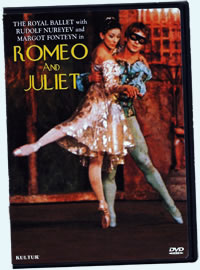Romeo and Juliet
Rudolph & Margot Trump Romeo & Juliet
The Royal Ballet/Kultur (1966)
Directed by Paul Czinner, choreographed by Kenneth MacMillan. With Rudolph Nureyev (Romeo), Margot Fonteyn (Juliet), Anthony Dowell (Benvolio), David Blair (Mercutio), Desmond Doyle (Tybalt), Julia Farron (Lady Capulet), Michael Somes (Lord Capulet), Gerd Larsen (Nurse).
 You can approach this broadcast of the Sergei Prokofiev–composed, Kenneth MacMillan–choreographed, Royal Ballet production of William Shakespeare's Romeo and Juliet three ways: as entertainment, as dance, and as Shakespeare. Score it one big loss, one big win, and one eh.
You can approach this broadcast of the Sergei Prokofiev–composed, Kenneth MacMillan–choreographed, Royal Ballet production of William Shakespeare's Romeo and Juliet three ways: as entertainment, as dance, and as Shakespeare. Score it one big loss, one big win, and one eh.
Filmed in 1966 at the Royal Opera House in Covent Garden a year after the production debuted, this Romeo and Juliet captures the most famous ballet pairing of all time, Margot Fonteyn and Rudolph Nureyev, in the title roles. They first danced together one year after his defection from the Soviet Union in 1961, and they would perform together on stage into 1988. Such was their status by the time MacMillan choreographed Prokofiev's Romeo and Juliet for the Royal Ballet that though he intended another pair to dance the lead roles, the company gave the parts to Nureyev and Fonteyn, who reportedly earned 43 curtain calls at the premiere. This DVD's raison d'existence is to keep this phenomenal performance available for posterity, for what you are watching here is undoubtedly cultural history.
Unfortunately, it feels like watching history. Technically speaking, the film is in dire need of doctoring. The sound is muffled, except for the snaps, crackles, and pops, while the film itself has scratches and breaks. The visuals are flat, too. The stage scenery may have looked delightful from a seat in the stalls, but on the screen the crayon-colored set crowds in on the dancers—holding a watercolor painting up two inches from your eyes while you try to discern the moving figures on it couldn't be more difficult.
These faults are the age in which the film was made and the age of the film itself. A timeless fault is that of producer and director Paul Czinner's over-frequent use of close-ups and edits from dancer to dancer. Ballet should be viewed in a wide context. Better to stick a camera in row K and let it alone capture the entire stage, the full scope of the corps de ballet, and the breadth of each pas de deux and solo. Ballet generally does not need close-ups because the dancers over-emote as part of their art, projecting to the back of the hall just as an actor does with his or her voice. For those who care about these things, the close-ups also clearly reveal a Juliet who is obviously not 13. In fact, at 47, Fonteyn was 19 years senior to Nureyev, a fact that becomes obvious every time the camera moves in. Long established as the world's greatest ballerina of the mid-20th century, Fonteyn was thought to be sliding toward retirement when she met Nureyev. The pairing didn't just rejuvenate her career, it sent her to new heights beyond those of Nureyev's one-armed lifts.
Fonteyn's en pointe skills are exquisite in this performance. When Paris (Derek Rencher) comes courting after Romeo's departure, Fonteyn's Juliet rises to her toes and slips away from him, backing across the room en pointe, straight armed, and head cocked, her posture and movement portraying a fragile thing caught in an impossible trap, and she ends by looking longingly toward the window through which Romeo had departed. When they dance together, she and Nureyev meld into one being, his graceful athleticism working with her fluid yet pinpoint-perfect phrasings. Sometimes you see Nureyev misstep, and that's fine because that's part and parcel of ballet, the most athletic of the arts. More often, though, he, she, and they will make your heart skip a beat as even simple steps say so much about their characters' emotions in the moment. The morning after the marriage scene is indescribable, except to say it might just be the most beautiful and perfectly performed dance you will ever see.
The best gauge of their talents is to compare them with the rest of the company. The Royal Ballet was then and still is one of the premier companies in the world, and yet nobody in this cast holds a candle to Nureyev and Fonteyn, save one. Anthony Dowell plays Benvolio, and his lifts and precision are evidence of a young dancer on the rise. Dowell would become a principal dancer for the Royal Ballet (and the American Ballet Theatre, too) and eventually its artistic director. He would gain his own fame in the '70s as Romeo opposite Antoinette Sibley's Juliet.
Watching Fonteyn, Nureyev, and Dowell is this film's real redeeming value. The ballet as a whole doesn't stand the test of time. Prokofiev's famous score, which he completed in 1935 (but couldn't get performed in his homeland of Russia, finally debuting in Czechoslovakia in 1938), is a bombastic thing. The marketplace dances sound may have inspired the theme song for Dallas, the Capulets enter to something Stalin might consider a bit heavy-handed, and the Prince's appearance is an end-of-the-world, three-note explosion by the entire orchestra with sustained drum roll, the symphonic equivalent of a tornado. When he does lighten up, Prokofiev displays a deft touch, such as the lilting, flute-led tune that Juliet dances to in her scenes with Paris. On the whole, though, it's uncertain that Prokofiev really understood the Shakespeare play he was scoring because he did, in fact, originally give it a happy ending (academics' opposition to his ending was part of the reason he had trouble getting the ballet staged in Moscow).
Romeo and Juliet was MacMillan's first full-length choreography and was highly acclaimed, remaining in the Covent Garden repertoire for decades. He, too, gives the original play little sacred regard, starting with Romeo taking part in the opening brawl along with Mercutio (David Blair), and Nurse (Gerd Larsen) taking part in the wedding in Friar Laurence's cell. Rosaline (Georgina Parkinson) gets prominent stage time, as Romeo—along with every other guy in Verona, it seems—actively courts her even at Capulet's party. Rosaline is, however, the apparent established girlfriend of Tybalt (Desmond Doyle), and her attention to Romeo—yes, this Rosaline gives Romeo good reason to hope—is what seems to goad Tybalt's hatred most. He takes on Mercutio for the same reason.
Blair's Mercutio is, for the most part, sloppily danced, though that may have been intentional characterization; he displays real skill in the semicomic fight with Tybalt. Mercutio is killed from behind (not under the arm of Romeo, who's off to the side), but we don't get the full impact because of Czinner's clumsy edits. Tybalt doesn't run off but looks on with pride, Count Tyrone Rugen–like, at his cowardly handiwork, whereupon Romeo rushes upon him with a vengeance. While the fights are well choreographed and danced, both deaths are done in an acting style reminiscent of Bottom playing Pyramus. The play's last half is crammed into the ballet's last of three acts. The "come night" scene is excised as is Romeo's scene with Friar Laurence. The scenes concerning Laurence's waylaid letters to Romeo in Padua, and Romeo learning of Juliet's death have also been cut; instead, Romeo enters the crypt last in a line of hooded monks at Juliet's funeral, and Laurence never shows up.
MacMillan's greatest departure from Shakespeare's text is his inserting three harlots into the plot. It is his method of showing how much Juliet has affected Romeo. Before he met her, he has an overly casual relationship with the harlots. Post-Juliet, Romeo pays the whores little heed. MacMillan is more successful in portraying Juliet's coming of age. In a Wendy-fashion nightgown and carrying a doll, Fonteyn in her movements makes Juliet very much the prepubescent girl upon first appearance (as long as the camera keeps its distance). Out of girlish bashfulness rather than disdain, she's apprehensive of Paris's first approach, and Romeo awakens fascination in her as much as sexual stirrings. The balcony scene is full of sexual innuendo, and she urges the marriage before Friar Laurence (Ronald Hynd, costumed and bearded as a stained-glass Jesus icon). Fonteyn's Juliet twice becomes reluctant to take the death-like sleep potion given her by Laurence. In the first instance in the Friar's cell, the ghostly father encourages her to pray about her trepidation, and through prayer she becomes resolved to go through with the plot; in the second instance, of her own accord she bows before an altar in her bedroom and, again, prayer leads her to resolve. Shakespeare gives his play a strong Catholic underpinning, and the idea that Friar Laurence is, in fact, an agent of God's will is a powerful possibility—especially if you cut out Laurence's later missteps, as MacMillan does.
Of course, the real reason the harlots are there is to provide three women dancers opposite the three best buddies, Romeo, Mercutio, and Benvolio. MacMillan's choreography ultimately is less about Shakespeare's play and more to do with ballet conventions. You have to have the corps de ballet, so in addition to the brawl (and the flailing swords all across the stage while the harlots and good girls catfight on the side is all great fun) and Capulet's masque, we get lots of scenes of people dancing in the marketplace. It is not Nurse who comes in to wake Juliet and to find her supposedly dead but six waiting women dancing delightedly around the potion bottle lying obviously on the floor.
It would be fine to accept these conventions at face value and say, simply, this is a ballet based on Romeo and Juliet rather than being a balletic presentation of Romeo and Juliet except that 10 years later another choreographer would do a Romeo and Juliet more faithful to Shakespeare's text while visually incorporating the imagery in his verse. That choreographer was Nureyev. I saw that ballet live at the London Festival Ballet, and Nureyev's unusual pas de deux with Benvolio, who brought him news of Juliet's death, was achingly beautiful. Several years later when I saw the MacMillan version at the Royal Ballet (with Dowell as Romeo opposite Lesley Collier), I felt cheated, despite my admiration for the two principal dancers.
However, despite all the reasons to feel cheated sitting through this DVD, I don't. Watching Fonteyn and Nureyev doing the first meeting scene, their balcony scene, their bedroom scene, and their death scene, and watching Fonteyn's Juliet grapple with her circumstances is a reward for passing time on this earth.
Eric Minton
August 28, 2013
Comment: e-mail editorial@shakespeareances.com
Start a discussion in the Bardroom



 Find additional Shakespeareances
Find additional Shakespeareances